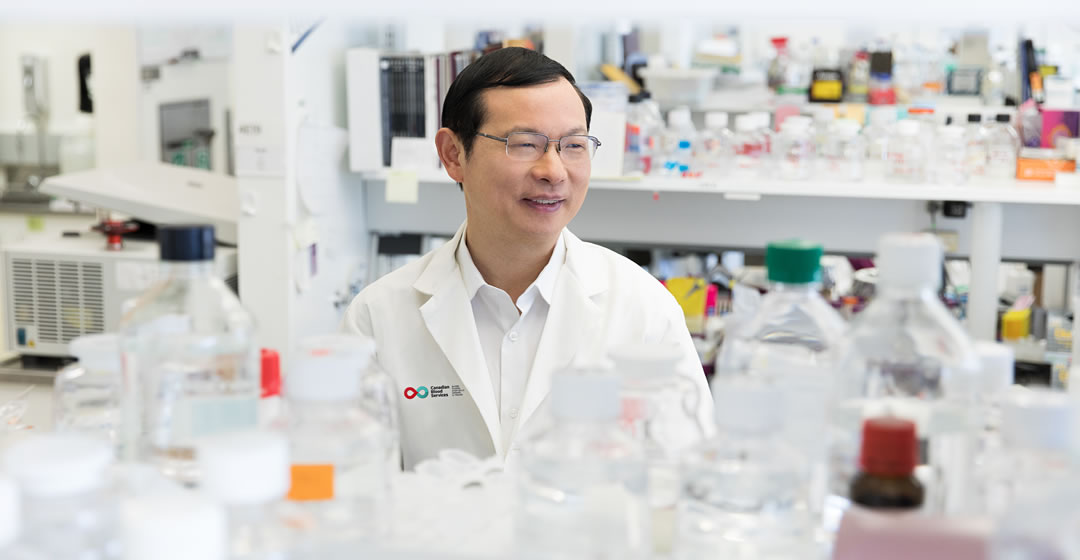
Dr. Chantale Pambrun: director, Centre for Innovation, Canadian Blood Services
We’re combining practical research, innovative development and valuable knowledge sharing.”
For Dr. Chantale Pambrun, director of the Centre for Innovation at Canadian Blood Services, supporting collaborative investigation is critical to ensuring the effectiveness of Canada’s health systems and delivering superior patient care. We asked her to describe the centre’s goals and impact.
What is the vision behind the Centre for Innovation?
Our role within Canadian Blood Services is to gain deeper insights along what we call the life-to-life continuum: the interconnected steps that lead from donors, through the various aspects of collection, production and distribution — to the patients who need our products and services to sustain and improve their lives. All of the work done by the network of researchers we support is aimed at informing and optimizing Canada’s biological lifeline. We’re constantly shining a light along that continuum, making sure there’s not one dark spot, to support the progressive, sustainable operation of our public health-care systems.
Where does the centre focus its efforts?
We have three functional areas, all aligned to patient needs and designed to keep Canadian Blood Services at the forefront of medicine.
One area provides new insights through discovery research — work driven by investigators who are trying to answer important scientific and medical questions as they focus on transfusion practices and the potential uses of blood-forming stem cells. It’s mostly the kind of research people picture when they think of scientists working in labs.
This is not just about pursuing knowledge for its own sake. Our researchers address practical challenges like ensuring that blood products are used appropriately and efficiently; optimizing quality while maintaining adequate supply; minimizing the potential adverse effects of transfusion; and improving or replacing current products with new therapies and technologies. Our teams publish their findings in peer-reviewed journals and share them directly with the health-care community to ensure that valuable insights travel quickly across our network “from bench to bedside,” where new knowledge can have a positive impact on patient care.
Do you create any new products in your labs?
Yes, that’s another unique functional area of the centre — product and process development. Many investigators on our diverse team are looking at ways to improve established products and the processes used to manufacture them. Others are developing superior next-generation alternatives to what’s currently available.
During the past fiscal year, our development labs completed 68 production improvement projects. To give you just a couple of recent examples … One team supported the quality assessment of new processing equipment that’s used to produce the more than 100,000 platelet units Canadian Blood Services distributes annually. Another project developed a better-quality control testing process to ensure that our systems were operating safely and effectively and also to make more products available for patient care.
So, these are the kinds of projects we’re tackling every day. We also test new products and processes rigorously before introducing them to patients, pushing the limits within the safety of our labs to avoid any compromise of our supply chain. Similarly, before any new technology comes online, we put the equipment through its paces and tweak it for optimum performance. And we have a team working on specialized development projects at our small-scale collection and production facility in Vancouver, which focuses exclusively on research.
How is all of this work shared with the health-care community?
That’s the last of our three functional areas — knowledge mobilization and strategic alliances. We support Canada’s health systems and also connect with the global health-care community by building a network of people, knowledge and resources — all with the goal of translating new insights into action. We run competitive funding programs for research that address the priorities of transfusion and transplantation science and medicine. And we fund and deliver education and training programs to support professional development in the medical and scientific communities. By gathering and synthesizing the evidence-based knowledge within our networks, we’re helping to shape policy, define best clinical practices and guide future research.
How many people work at the Centre for Innovation?
You may be surprised to know that we have 85 people on staff. Most work on research teams — comprised of primary investigators and their assistants and students — in our seven research and four development labs. The knowledge mobilization group is smaller, accounting for about 10 per cent of our annual budget; however, during the last year alone, more than 3,750 professionals benefited from more than 400 learning opportunities. And then we have many individuals who are part of our wider innovation community.
We invest around 30 per cent of our funding in competitive research programs; in 2018, we supported 60 investigators financially and supplied another 41 researchers with blood products allocated for research. And we also use the centre’s digital channels to provide instant access to timely information — our website doubled its page views over the past year.
So, the ultimate goal is to maximize the Centre’s impact?
That’s right — which, of course, reinforces the overall purpose of Canadian Blood Services: ensuring that Canada has a safe, effective and responsive system for delivering blood and related biological products to patients in need. The Centre for Innovation plays a key role internally, helping maintain the highest standards of safety and quality all along the supply chain — our life-to-life continuum. The research efforts that we guide and support also have a wider impact, helping to equip Canada’s health systems with the advanced products and tools, as well as the proven practice guidelines, that are necessary to bridge current gaps and meet the needs of the future. Those needs are evolving faster than ever. And that’s what brings us to work each morning, knowing that we’re combining practical research, innovative development and valuable knowledge-sharing to help deliver the best possible patient care.
Sharing vital
knowledge
During 2018–2019, the Centre for Innovation’s network produced 246 knowledge products — including 163 peer-reviewed publications — all focused on enhancing our understanding of the products and services we provide, as well as the patient populations we serve in Canada’s health systems.
